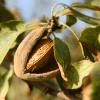Position
Plant your almond trees in full sun with at least 4 metres of space all around for future growth.
Size
These trees will grow to a height of between 4 and 6 metres. They will fruit after 2 years and reach full fertility at 4 years.
Soil Type
Almond trees grow in all soil types, including chalky soil. Ad a bag of Volcanic Rock Dust, which contains organic minerals and trace elements to create healthy soil and increase important micro-organisms in the ground.
Superfrass (R25 per bag) is a natural high quality organic growth enhancer and pesticide which you could add when planting.
Mulch
All fruit trees thrive if they are protected with good-quality mulch. Generous servings of pine bark mulch and green pine needles spread around the trunk of the tree help eradicate weeds, bring the pH down slightly, and protect the roots from the harsh UV sun rays. Mulch also helps to keep the roots damp. But, be careful not to apply mulch too close to the tree trunk, as the water it retains can cause the trunk to rot.
Watering
The almond tree roots do not like to be waterlogged. A good soaking every 4 to 5 days in spring and summer is preferable.
Fertilising
Boron is recommended when planting your almond tree. Use our slow-release nitrogen-rich all plant fertiliser. Apply 1 teaspoon every 4-5 months.
Pruning
Prune dead branches in winter. Maintain a V-shape in the canopy to allow for better light penetration.
Pests
Watch out for borer worms, as they will attack the hardwood trunk of the tree. Even young trees are at risk.
Harvesting
Flower buds open before the leaf buds in spring. Blossoms last about 2 weeks and the fruit develops in mid-summer. The inner shell completes its development 3 months after blossoming. Harvesting takes place in February and March. Almond trees will give maximum yield at 7 to 9 years old, and can produce for up to 40 years.






